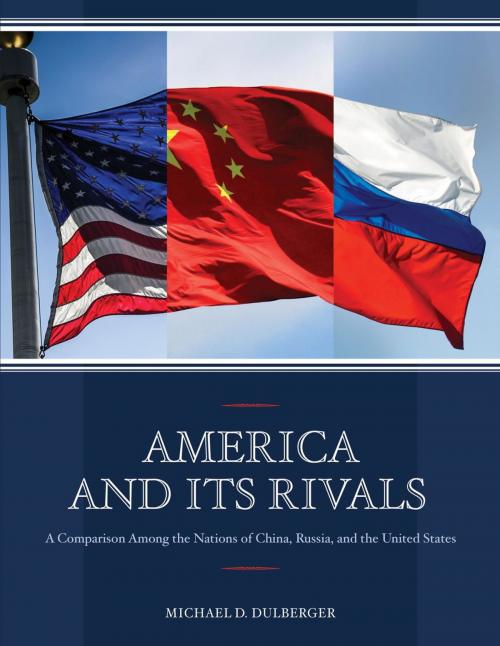America and Its Rivals
A Comparison Among the Nations of China, Russia, and the United States
Nonfiction, Social & Cultural Studies, Social Science, Statistics, Demography, Political Science, International| Author: | Michael D. Dulberger | ISBN: | 9781598889994 |
| Publisher: | Bernan Press | Publication: | May 7, 2018 |
| Imprint: | Bernan Press | Language: | English |
| Author: | Michael D. Dulberger |
| ISBN: | 9781598889994 |
| Publisher: | Bernan Press |
| Publication: | May 7, 2018 |
| Imprint: | Bernan Press |
| Language: | English |
How does the United States compare when objectively measured shoulder-to-shoulder against the world’s two most influential autocracies? This full-color book provides a solid foundation to enable the reader to create informed opinions about China, Russia, and the United States through comparative examination of their global status and the quality of their peoples’ lives. Data resources—created by many respected organizations including the World Bank, the United Nations, the Center for Disease Control (CDC), and Freedom House, to name a few—have been mined to provide direct comparisons between many key characteristics including health, wealth, poverty, education, employment, crime, imprisonments, freedoms, happiness, natural resources, infrastructure, debt, taxes, trade, military assets, and nuclear warheads.
It is the author’s mission to present meaningful data—all with attributed sources—in an inviting, graphic format to convey much more information than would be possible in tabular form. By directly displaying data the usual biases and filters are bypassed enhancing your ability to draw your own conclusions. This visual approach very effectively reveals trends and makes differences between nations and their people self-evident.
In the United States (2016):
- 64,100 people died of drug overdose and 2.2 million people were in prisons
- The top twenty percent of households received 51.5 percent of all income
- 1.2 trillion dollars were added to debt and 241 billion was paid in interest
- Foreigners held one-third of federal debt including 1.1 trillion by China
In comparison with the United States Russia had:
- 12.5 years lower life expectancy for males born in 2016 (only 65.0 years)
- Double the homicide rate and 40 percent higher suicide rate
- 60 percent higher alcohol consumption per capita
- An economy one-fifth as large, measured by GDP in international dollars
- Equivalent number of nuclear warheads (approximately 7,000)
- Double the crude oil reserves and five times the natural gas reserves
- Repressive government—rated within the worst 10 percent by Freedom House
- 14 times as many residents (67,000) seeking asylum
In comparison with the United States China had:
- An economy 15 percent larger, measured by GDP in international dollars
- Three times as many patent applications filed by residents
- One-fifth the homicide rate and one-half the poverty rate
- 58 percent more outbound international tourists
- 61 points higher scores in mathematics literacy for students aged 15 years
- Double the total carbon dioxide emissions
- Repressive government—rated within the worst 10 percent by Freedom House
- 44 times as many residents (212,000) seeking asylum
How does the United States compare when objectively measured shoulder-to-shoulder against the world’s two most influential autocracies? This full-color book provides a solid foundation to enable the reader to create informed opinions about China, Russia, and the United States through comparative examination of their global status and the quality of their peoples’ lives. Data resources—created by many respected organizations including the World Bank, the United Nations, the Center for Disease Control (CDC), and Freedom House, to name a few—have been mined to provide direct comparisons between many key characteristics including health, wealth, poverty, education, employment, crime, imprisonments, freedoms, happiness, natural resources, infrastructure, debt, taxes, trade, military assets, and nuclear warheads.
It is the author’s mission to present meaningful data—all with attributed sources—in an inviting, graphic format to convey much more information than would be possible in tabular form. By directly displaying data the usual biases and filters are bypassed enhancing your ability to draw your own conclusions. This visual approach very effectively reveals trends and makes differences between nations and their people self-evident.
In the United States (2016):
- 64,100 people died of drug overdose and 2.2 million people were in prisons
- The top twenty percent of households received 51.5 percent of all income
- 1.2 trillion dollars were added to debt and 241 billion was paid in interest
- Foreigners held one-third of federal debt including 1.1 trillion by China
In comparison with the United States Russia had:
- 12.5 years lower life expectancy for males born in 2016 (only 65.0 years)
- Double the homicide rate and 40 percent higher suicide rate
- 60 percent higher alcohol consumption per capita
- An economy one-fifth as large, measured by GDP in international dollars
- Equivalent number of nuclear warheads (approximately 7,000)
- Double the crude oil reserves and five times the natural gas reserves
- Repressive government—rated within the worst 10 percent by Freedom House
- 14 times as many residents (67,000) seeking asylum
In comparison with the United States China had:
- An economy 15 percent larger, measured by GDP in international dollars
- Three times as many patent applications filed by residents
- One-fifth the homicide rate and one-half the poverty rate
- 58 percent more outbound international tourists
- 61 points higher scores in mathematics literacy for students aged 15 years
- Double the total carbon dioxide emissions
- Repressive government—rated within the worst 10 percent by Freedom House
- 44 times as many residents (212,000) seeking asylum















